
Sportlight_7
.pdf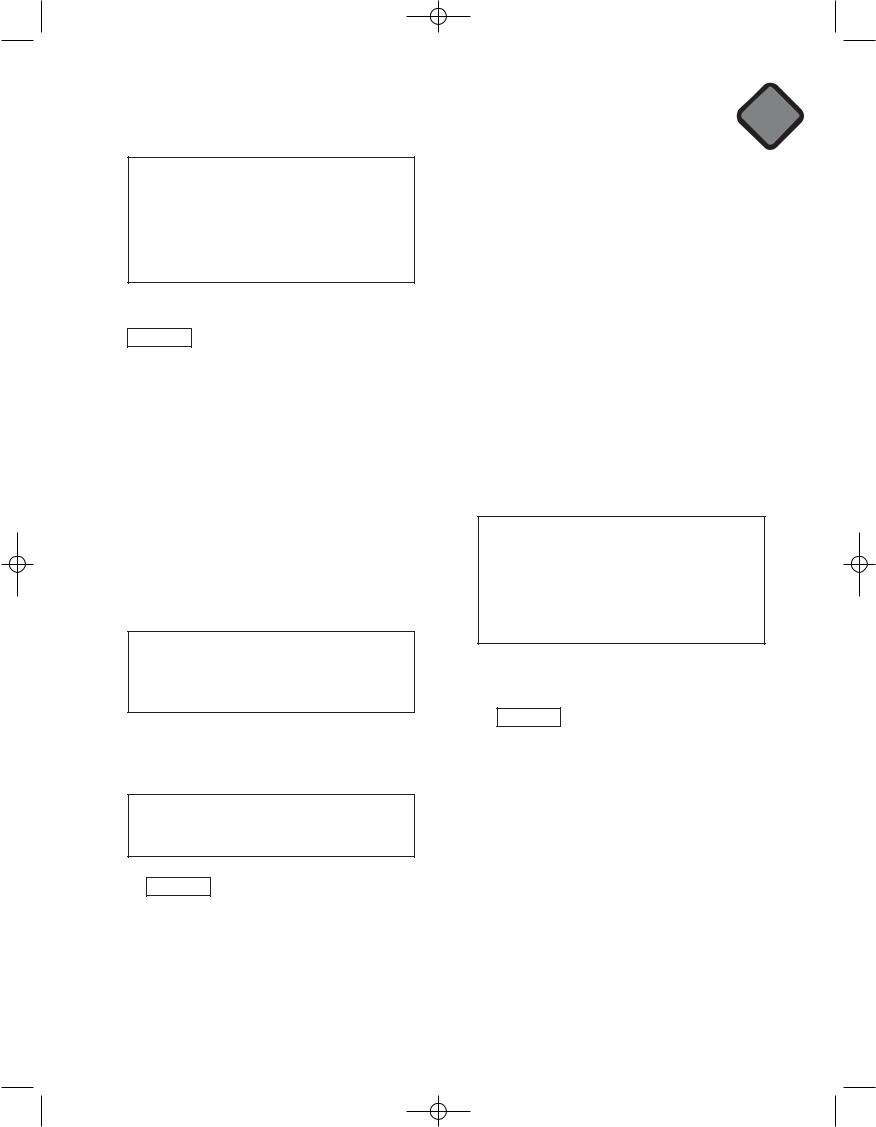
Spotlight 7 ts Mod 08 12-09-08 15:02 Page 111
Suggested Answer Key
A:Can I help you plant those flowers?
B:Yes, please!
A:Would you like me to clean out the pond with you?
B:No, thanks. I can manage.
Grammar
6Focus Studying and practising grammar
ñWork with books closed. Write the following sentences on the board: She's coming later, isn't she? He likes meat, doesn't he? He will call, won't he?
ñElicit/Explain what the phrases in bold are (question tags). Elicit/Explain when we use them (when we want to confirm sth or if we want to know if sth is true or not).
ñElicit other examples from class. Ask Ss to open their books. Read the rubric aloud and elicit/ explain how we form question tags. Choose two individual Ss to read the examples aloud. Check understanding. If there are difficulties, refer Ss to the Grammar Reference Section for further detail.
Answer Key
We form a question tag with the auxiliary or modal verb of the main sentence and the appropriate subject pronoun.
ñAsk Ss to look at the dialogue again. Allow them time to find question tags. Ss compare answers. Check Ss’ answers.
Answer Key
Sally collects … , doesn’t she?
I could … , couldn’t I?
7 a) Focus Practising intonation in question
tags
ñWork with books closed. Explain/Elicit what it means when our voice goes down when using a question tag (we are sure of the answer and expect agreement). Explain/Elicit what it means when our voice goes up when using a question tag (we aren't sure of the answer and
Eco-helpers 8b
want confirmation). Write these
the board: It's raining again, isn't won't fall, will he?
ñRead out the first sentence, using a intonation on the question tag. Ask the question tag means (we are sure answer and expect agreement). Read
second sentence with a rising intonation on the question tag. Ask Ss what the question tag means (we aren't sure of the answer and want confirmation).
ñAsk Ss to open their books. Read out the rubric and explain the task. Allow Ss time to fill in the question tags. Check Ss' answers.
ñPlay the recording as Ss listen and tick the correct boxes. Check Ss' answers.
ñAsk Ss to look at their answers (the boxes they have ticked) and say whether the speaker was sure or unsure about what they said. Accept feedback.
Answer Key
1 is she? ― falling/sure
2 aren’t they? ― rising/not sure
3 didn’t he? ― rising/not sure
4 isn’t she? ― rising/not sure
5 can we? ― falling/sure
6has she? ― falling/sure
b)Play the recording while Ss listen and repeat. Check intonation.
8 a) Focus Reviewing (don’t) have to
ñWork with books closed. Write the following sentences on the board: I have to stay home and study. You don't have to make lunch today.
ñExplain to Ss that the first sentence shows that it is necessary for the speaker to stay home and study and that the second sentence shows that it is not necessary for the person addressed to make lunch.
ñElicit other examples from the class. Ask Ss to open their books and read the study box quietly. Check Ss' understanding and help with any difficulties if necessary.
ñAllow Ss time to find examples of (absence of) necessity in the dialogue. Ss compare answers. Check Ss' answers.
111
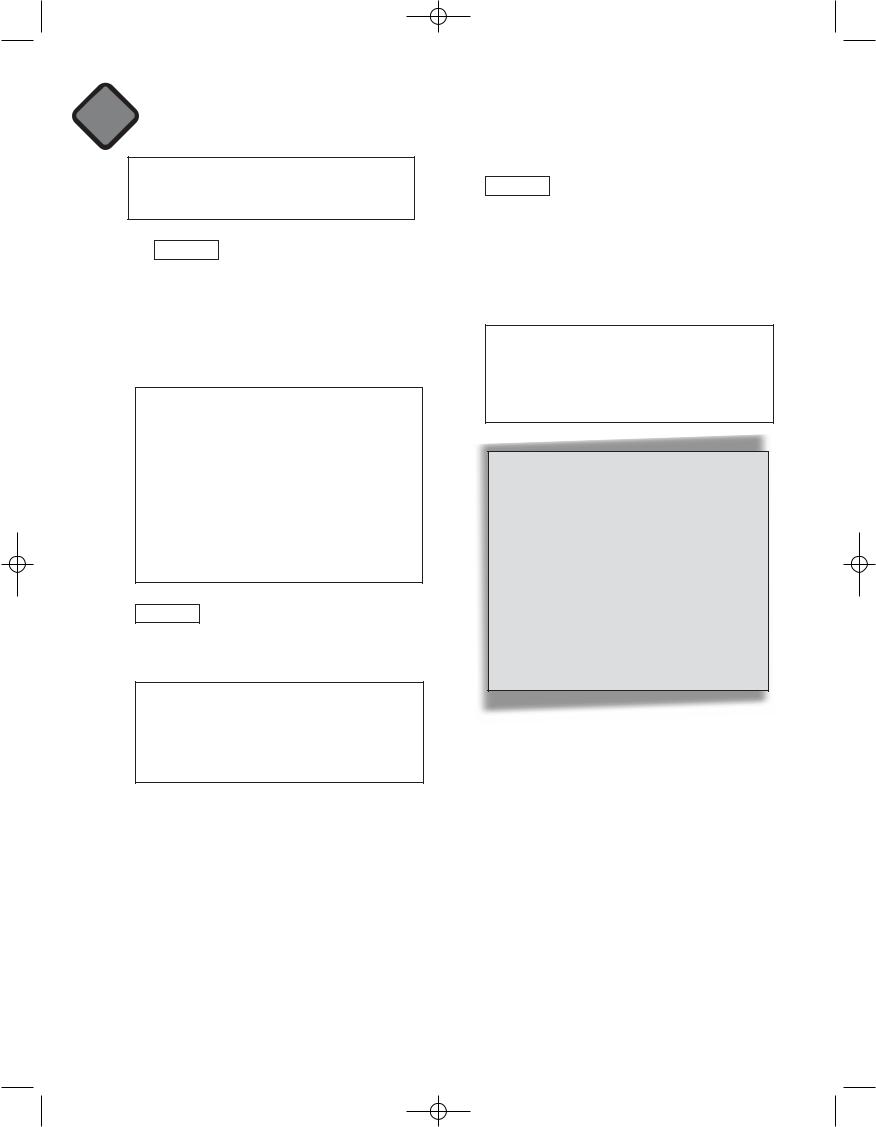
Spotlight 7 ts Mod 08 12-09-08 15:02 Page 112
8b Eco-helpers
Key
will have to leave the city; you have to Miss Jackson first
b) Focus Practising using (don’t) have to
Draw Ss’ attention to Roger's list. Choose individual Ss to read out the tasks. Explain/Elicit the meaning of any unknown words. Explain the task. Do the first exercise as a class. Have one S read out the example answers. Allow Ss time to complete the task. Check Ss' answers.
Answer Key
2He has to call the recycling centre, doesn’t he?
3He doesn’t have to tidy the eco-library, does he?
4He has to clean out the clubhouse, doesn’t he?
5He doesn’t have to buy more nails and wood, does he?
6 He has to give out membership cards, doesn’t he?
Focus Personalising
c)Elicit responses from Ss as to what they have to do today.
Suggested Answer Key
I have to do my homework.
I have to feed the cat and tidy my room.
I don’t have to do the washing up today.
I don’t have to go to bed early. It’s Friday.
Writing
9Focus A list
Have a S read out the task and help him/her explain the task. Group Ss at random. Ss in groups think about what activities they should include and write their lists. Monitor the task and help Ss where necessary. Check each group’s work. Ask several groups to present their work to the class.
Suggested Answer Key
Mary & Tony order trees.
John & Peter buy more wood and nails.
Tina & Barbara inspect the tools.
Tim & Cathy tidy the eco-library.
Synergy
ñAllow Ss one minute to think about language, pronunciation and grammar structures they have learnt in this lesson. Ask Ss to use them in their own sentences.
ñWhen Ss have finished ask them to get up and go around the class to find a partner who has something in common with them e.g. same hair/eye colour, same clothes, same taste in music, etc.
ñAsk Ss to discuss what they have learnt in the lesson with their partner.
112
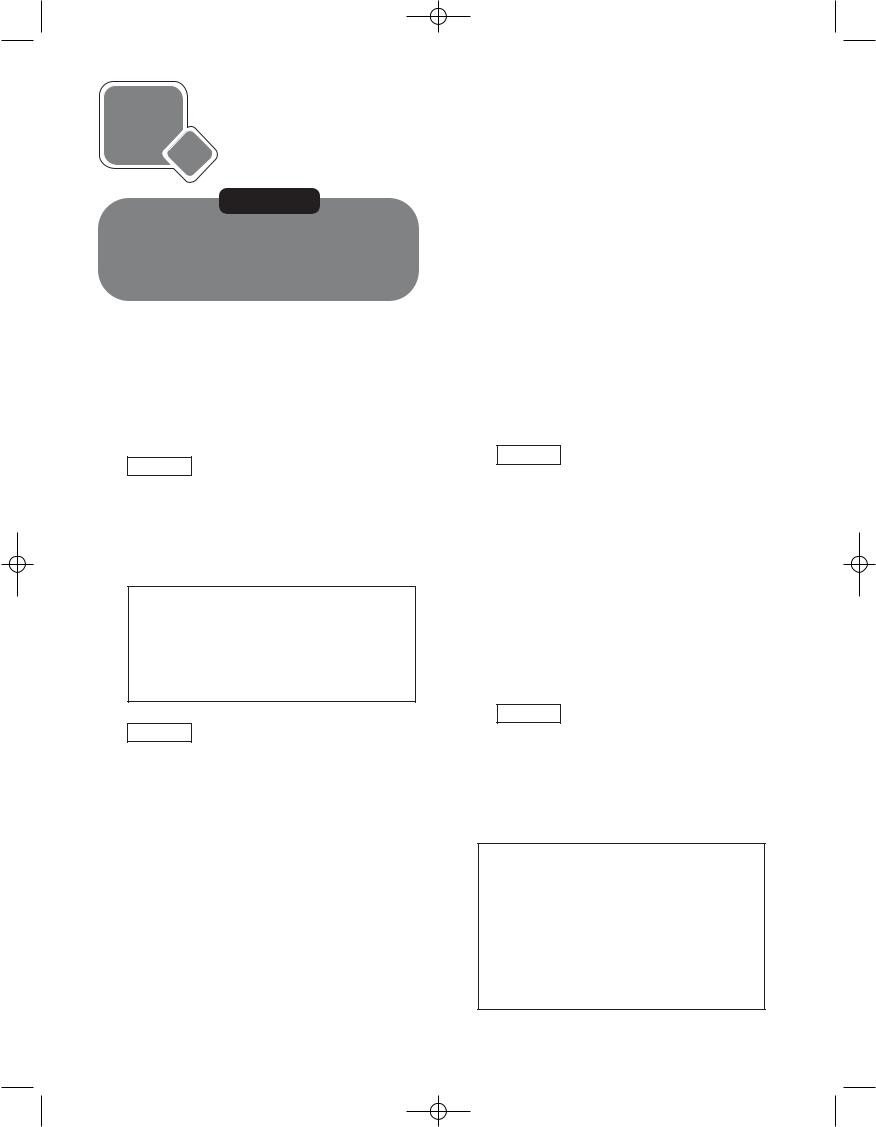
Spotlight 7 ts Mod 08 12-09-08 15:02 Page 113
8 c Born free
Objectives
Vocabulary: related to animals & habitats Reading & Listening: a for-and-against essay about zoos
Writing: a for-and-against essay
Introduction
Draw Ss' attention to the title, Born free, and ask them what they think it means. (Wild animals born in their natual habitat.) Encourage Ss to predict what vocabulary they will see in the unit.
Vocabulary
1Focus Building vocabulary related to
animals and habitats
Focus Ss’ attention on the list of words and the pictures. Elicit/Explain the meaning of any new words. Explain the task. Allow Ss time to complete the task. Ss compare answers. Check Ss’ answers.
Suggested Answer Key
2 Parrots live in tropical rainforests.
3 Black bears live in woods.
4 Penguins live in polar regions.
5 Alligators live in wetlands.
6 Giraffes live in savannahs.
2Focus Discussing a topic
ñHave a S read out the rubric and the statement. Check Ss’ understanding of the task. Elicit/Recycle the meaning of the unit title and make two columns on the board for each category (pros – cons). Brainstorm and list Ss’ ideas under the appropriate category on the board (i.e. pros or cons).
ñAllow Ss’ time in pairs to prepare and practise their discussions. Walk around the classroom monitoring Ss’ work and helping where necessary. Ask individual pairs to present their discussions to the class. Correct Ss where necessary.
Suggested Answer Key |
|
|
|
|
|
|
|
|
|
|
Pros |
|
Cons |
|
|
Zoos help certain |
|
Animals should not |
|
|
animal species |
|
live in cages. They |
|
|
survive. |
|
should be free. |
|
|
They are |
|
The environment is |
|
|
educational; |
|
not ideal so some |
|
|
children have the |
|
animals die. In |
|
|
chance to see wild |
|
some zoos animals |
|
|
animals. |
|
are mistreated. |
|
|
|
|
|
|
|
|
|
|
|
Reading & Listening
3 a) Focus Listening & reading for gist
ñExplain the task. Play the recording as Ss listen to and read the essay. Play the recording again and ask Ss to circle the arguments they had not thought of/were not listed.
ñAsk several Ss around the class to summarise the points in favour and against. Elicit that in a for & against essay, there is usually no clear cut solution or opinion; and that a balanced outlook should be maintained. However, focus on the last paragraph where the author has stated his opinion.
(Ss’ own answers)
b)Focus Building vocabulary
ñAsk Ss to explain the meaning of the words in bold without the use of a dictionary, i.e. they can use synonyms, paraphrase etc. Elicit/ Explain the meanings and write them on the board. Ss should copy the words into the vocabulary section of their notebooks.
Answer Key role (n): part
in danger (exp): threatened
endangered species (exp): animals and plants that are rare/threatened
survive (v): continue to exist act (v): behave
drawbacks (n): disadvantages recreate (v): copy, replicate
113

Spotlight 7 ts Mod 08 12-09-08 15:02 Page 114
8c Born free
cages (n): fortified containers for animals arguments (n): cases for and against sth for (prep): in favour of sth
against (prep): opposed to sth environment (n): everything around us
4 a) Focus Analysing a for-and-against essay
Draw Ss’ attention to the essay and ask each of the questions in the rubric one at a time. Explain any new vocabulary. Elicit answers from individual Ss. Check Ss’ answers.
Answer Key
a 1 |
b 4 |
c 2 |
d 3 |
b) Focus Reviewing linking words
Draw Ss’ attention to the underlined words and phrases and ask the questions in the rubric one at a time. Explain any new vocabulary. Allow Ss time to complete the task. Elicit answers around the class. Check Ss’ answers.
Answer Key
Give a personal opinion: I believe
Give an opposite opinion: On the other hand, However
Add reasons: In addition, Furthermore Introduce a conclusion: To sum up Introduce an argument: On the one hand
5Focus Preparing to write a for-and-against
essay
Have a S read out the rubric and help him/her explain the task. Check Ss understand the topic
(keeping wild animals as pets). Give or have Ss come up with an example of a wild animal being kept as a pet (e.g. a tiger). Allow Ss some time to read through the arguments listed in their books and explain/elicit the meaning of any unknown words. Go through the items one at a time asking Ss around the class to classify the arguments as pros or cons. In random groups, Ss think of reasons or examples to support the arguments. Monitor the task and help Ss if necessary. Check Ss’ work. Ask groups to present their work to the class.
Suggested Answer Key
ñOwners … ― con (Books are not always accurate.)
ñThey … ― con (they get sick when they do not live in their natural habitats.)
ñIt is … ― pro (And you can persuade others to help, too.)
ñYou … ― pro (by giving them food and a place to live)
ñThey … ― con (because they are wild and can never be 100% domesticated)
Writing
6Focus A for-and-against essay
Go through the rubric with Ss and elicit key words
(essay, pros and cons, keep wild animals as pets, direct question). Elicit from Ss what they need to write. Brainstorm for ideas and write them on the board. Allow Ss time to complete the task in class. Check Ss' work and give feedback. Alternatively, you can assign the task for HW.
Suggested Answer Key
Would you like to have a monkey as a pet? To feed it and play with it and take it to the park? Well, think twice before you make any decisions. Things are not that simple.
Sure, on the one hand owning a wild animal is a very good way to learn about it. You also help conserve it.
On the other hand, there are certain drawbacks to keeping a wild animal as a pet. Most owners do not know how to look after a wild animal properly and books on the subject are not always accurate. Wild animals need special food and they often get sick when they do not live in their natural habitats. Furthermore, they can be dangerous.
To sum up, there are strong arguments both for and against keeping wild animals as pets. However, I believe that animals have rights, too, and that they should not be forced to live in strange environments. We should adopt animals in zoos rather than keep them as pets.
114

Spotlight 7 ts Mod 08 12-09-08 15:02 Page 115
|
|
8 d |
Culture Corner |
|
|
|
|
|
|
|
|
|
|
|
|
|
|
|||||||||
Reading & Listening |
|
|
|
|
|
ñ Ask Ss to explain the meaning of the underlined |
||||||||||||||||||||
|
|
|
|
|
|
|
|
|
|
|
|
|
words |
without |
the use of |
a dictionary, |
i.e. |
|||||||||
1 |
|
Focus |
Stimulating interest/predicting |
|
|
|||||||||||||||||||||
|
|
|
they |
can use |
synonyms, |
paraphrase, |
etc. |
|||||||||||||||||||
|
content |
|
|
|
|
|
|
|
|
|
||||||||||||||||
|
|
|
|
|
|
|
|
|
|
Elicit/ Explain the meanings and write them |
||||||||||||||||
|
|
|
|
|
|
|
|
|
|
|
|
|
||||||||||||||
|
Draw Ss' attention to the introduction on the |
on the board. Ss should copy the words into |
||||||||||||||||||||||||
|
webpage and the pictures. Read the rubric and the |
the vocabulary section of their notebooks. |
|
|
||||||||||||||||||||||
|
list of vocabulary. Explain/Elicit the meaning of any |
|
|
|
|
|
|
|
|
|
|
|
|
|
|
|||||||||||
|
Answer Key |
|
|
|
|
|
|
|
|
|||||||||||||||||
|
unknown words. Explain the task. Allow Ss time to |
|
|
|
|
|
|
|
|
|||||||||||||||||
|
rare species (exp) : uncommon animal |
|
|
|||||||||||||||||||||||
|
complete the task. Play the recording (twice if |
|
|
|||||||||||||||||||||||
|
necessary) as Ss check their answers. |
|
|
|
cliffs (n): a high area of land with a steep side |
|
||||||||||||||||||||
|
|
|
|
|
|
|
|
|
|
|
|
|
reserves (n): land kept for a special purpose |
|
|
|||||||||||
|
|
|
|
|
|
|
|
|
|
|
|
|
seabirds (n): birds that live near the sea and |
|
||||||||||||
|
|
Answer Key |
|
|
|
|
|
|
|
|||||||||||||||||
|
|
|
|
|
|
|
|
get their food from it |
|
|
|
|||||||||||||||
|
|
You can see cliffs, seabirds, underwater caves, |
|
|
|
|
||||||||||||||||||||
|
|
|
unique (adj): special, rare |
|
|
|
||||||||||||||||||||
|
|
wildlife, |
|
bluebells, |
deer, |
flocks |
of swans, |
|
|
|
|
|||||||||||||||
|
|
|
|
garlic (n): a strong-smelling plant used in cooking |
|
|||||||||||||||||||||
|
|
fieldmice |
|
|
|
|
|
|
|
|
|
|
||||||||||||||
|
|
|
|
|
|
|
|
|
|
|
rare (adj): unusual |
|
|
|
|
|
|
|
|
|||||||
|
|
|
|
|
|
|
|
|
|
|
|
|
|
|
|
|
|
|
|
|
||||||
|
|
|
|
|
|
|
|
|
|
|
|
|
wetlands (n): an area of very wet, muddy land |
|
||||||||||||
|
|
|
|
|
|
|
|
|
|
|
|
|
|
|||||||||||||
|
|
|
|
|
|
|
|
|
|
|
|
|
with wild plants growing on it |
|
|
|
||||||||||
2 |
a) |
Focus |
Reading for specific information |
|
|
|
||||||||||||||||||||
to nest (v): to build a nest and lay eggs |
|
|
||||||||||||||||||||||||
|
|
|
Go through each statement eliciting/explaining |
|
|
|||||||||||||||||||||
|
|
|
marshes (n): swamps, wetland |
|
|
|
||||||||||||||||||||
|
|
|
any new vocabulary. Ask Ss to read the texts to |
geese (n): birds similar to ducks |
|
|
||||||||||||||||||||
|
|
|
complete the task. Walk around the classroom |
hikes (n): walks |
|
|
|
|
|
|
|
|
||||||||||||||
|
|
|
monitoring Ss’ work and helping with difficulties |
|
|
|
|
|
|
|
|
|
|
|
|
|
|
|||||||||
|
|
|
|
|
|
|
|
|
|
|
|
|
|
|
|
|
||||||||||
|
|
|
where necessary. Check Ss’ answers. |
|
|
|
|
|
||||||||||||||||||
|
|
|
3 |
Focus |
Role playing a dialogue between a |
|||||||||||||||||||||
|
|
|
|
|
|
|
|
|
|
|
|
|
travel agent and a customer |
|
|
|
||||||||||
|
|
Answer Key |
|
|
|
|
|
|
|
|
|
|||||||||||||||
|
|
|
|
|
|
|
|
ñ Have a S read out the rubric and help him/her |
||||||||||||||||||
|
|
1 … ideal for diving. |
|
|
|
|
|
|||||||||||||||||||
|
|
|
|
|
|
|
explain the task. Write the |
headings on |
the |
|||||||||||||||||
|
|
2 |
… famous |
for its |
fantastic wildlife |
and |
|
|||||||||||||||||||
|
|
|
board and ask Ss for information to go under |
|||||||||||||||||||||||
|
|
|
woods. |
|
|
|
|
|
|
|||||||||||||||||
|
|
|
|
|
|
|
|
|
each of the headings. Allow Ss some time to |
|||||||||||||||||
|
|
3 |
Don’t |
|
miss |
the fantastic bird |
watching |
|
||||||||||||||||||
|
|
|
|
complete the task. |
|
|
|
|
|
|
|
|
||||||||||||||
|
|
|
hikes and nature trails … |
|
|
|
|
|
|
|
|
|
|
|
||||||||||||
|
|
|
|
|
|
ñ Go through a skeleton dialogue with Ss on the |
||||||||||||||||||||
|
|
|
|
|
|
|
|
|
|
|
|
|
||||||||||||||
|
|
|
|
|
|
|
|
|
|
|
|
|
||||||||||||||
|
|
|
|
|
|
|
|
|
|
|
|
|
board. Ss perform the task in pairs. Go around |
|||||||||||||
|
b) |
Focus |
Consolidating vocabulary |
|
|
the classroom monitoring Ss’ work and helping |
||||||||||||||||||||
|
|
|
ñ Explain the task. Check Ss’ understanding of |
with any difficulties. |
|
|
|
|||||||||||||||||||
|
|
|
|
|
|
|
|
|
|
|
|
|
|
|
|
|
||||||||||
|
|
|
the |
task. Ss complete |
the task |
individually. |
|
|
|
|
|
|
|
|
|
|
|
|
|
|
||||||
|
|
|
Student A |
|
|
|
|
|
Student B |
|
|
|||||||||||||||
|
|
|
Check answers with the class. |
|
|
|
|
|
|
|
|
|
|
|||||||||||||
|
|
|
|
|
|
Ask for the next |
|
|
|
|
|
Ask for the location |
|
|||||||||||||
|
|
|
|
|
|
|
|
|
|
|
|
|
|
|
|
|
|
|
||||||||
|
|
|
|
|
|
|
|
|
|
|
|
|
|
|
|
|
|
|
||||||||
|
|
|
|
|
|
|
|
|
|
|
|
|
customer. |
|
|
|
|
|
|
|
|
of a nature reserve. |
|
|||
|
|
Answer Key |
|
|
|
|
|
|
|
|
|
|
|
|
|
|
|
|||||||||
|
|
|
|
|
|
|
|
|
|
|
|
|
|
|
|
|
|
|
|
|
|
|||||
|
|
2 habitats: wetlands, woods |
|
|
|
Give customer |
|
|
|
|
|
Ask what it’s famous |
|
|||||||||||||
|
|
|
|
|
|
|
|
|
|
|||||||||||||||||
|
|
4 kinds of birds: Puffins, Golden Eagle, swans, |
|
information. |
|
|
|
|
for. |
|
|
|
||||||||||||||
|
|
geese |
|
|
|
|
|
|
|
|
|
Inform the |
|
|
|
|
|
|
|
|
Ask what you can |
|
|
|||
|
|
3 other kinds of animals: sheep, |
fieldmice, |
|
|
|
|
|
|
|
|
|
|
|
||||||||||||
|
|
|
customer. |
|
|
|
|
|
|
|
|
see there. |
|
|
||||||||||||
|
|
deer |
|
|
|
|
|
|
|
|
|
|
|
|
|
|
|
|
|
|
|
|||||
|
|
|
|
|
|
|
|
|
|
|
Provide information. |
|
|
|
|
Ask when the best |
|
|
||||||||
|
|
2 plants: bluebells, wild garlic |
|
|
|
|
|
|
|
|
|
|||||||||||||||
|
|
|
|
|
|
|
|
|
|
|
||||||||||||||||
|
|
|
|
|
|
|
|
|
|
|
|
|
|
|
time to visit is. |
|
|
|||||||||
|
|
|
|
|
|
|
|
|
|
|
|
|
Provide information. |
|
|
|
|
|
|
|||||||
|
|
|
|
|
|
|
|
|
|
|
|
|
|
|
|
|
|
|
||||||||
|
|
|
|
|
|
|
|
|
|
|
|
|
|
|
|
|
Thank. |
|
|
|||||||
|
|
|
|
|
|
|
|
|
|
|
|
|
|
|
|
|
|
|
||||||||
|
|
|
|
|
|
|
|
|
|
|
|
|
|
|
|
|
|
|
|
|
|
|
|
|
|
|
115
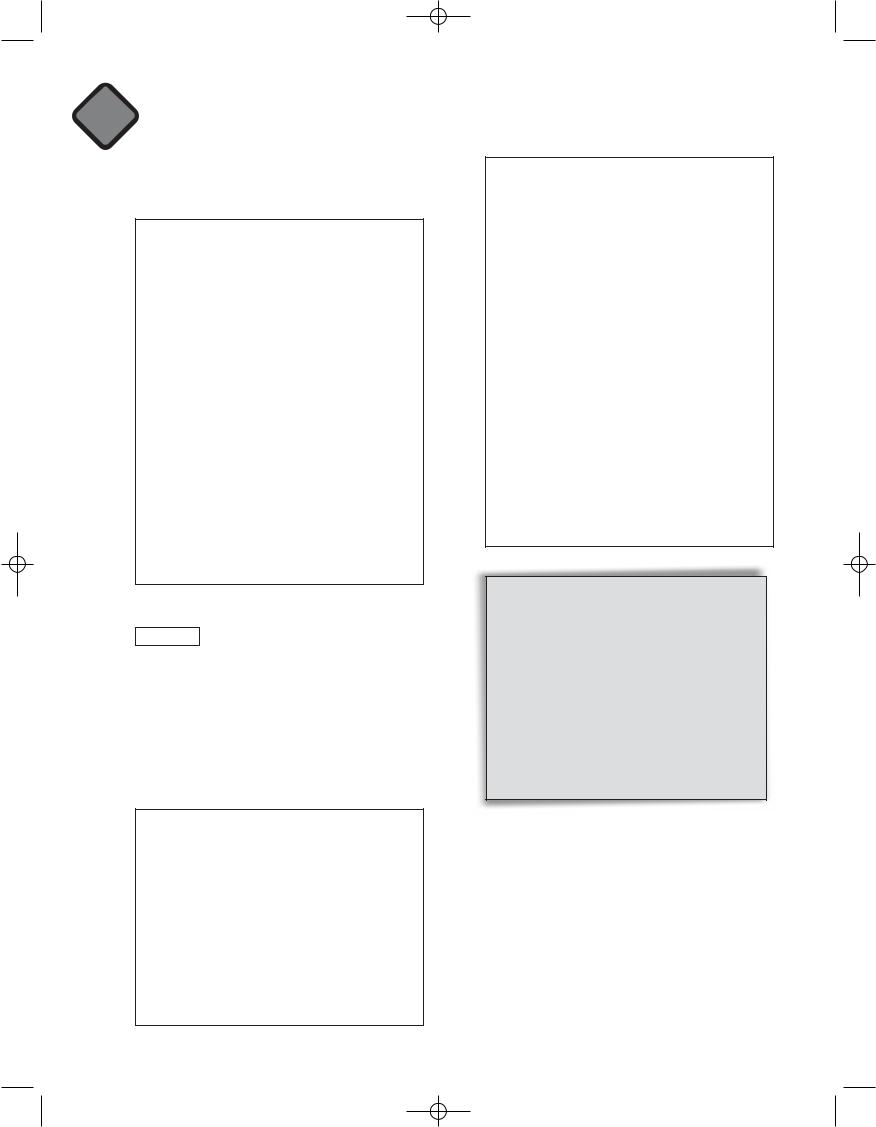
Spotlight 7 ts Mod 08 12-09-08 15:02 Page 116
8d Culture Corner
Ask pairs to act out their dialogue for the class. If possible, record pairs and play back for feedback puproses.
Suggested Answer Key
TA: Next, please.
C:I would like to travel to St. Kilda and I would like you to give me some information about nature reserves there.
TA: Of course. Well, St. Kilda islands are a reserve.
C:What is the reserve famous for?
TA: St. Kilda has the highest cliffs in Britain, over 1 million seabirds including puffins, and other unique species.
C:That sounds very interesting. What else is there to see and do?
TA: It is one of the best places to go diving because there are amazing clear waters and underwater caves and tunnels.
C:Wonderful. And when is the best time to visit?
TA: From May to June.
C:That’s great. Thanks very much.
Project
4Focus An article about nature
ñGo through the rubric with words (collect information, your country, article, decorate
Elicit from Ss what they Brainstorm ideas and write Allow Ss time to complete Check Ss' work and give feedback you can assign the task for HW.
Suggested Answer Key Kavkazkiy Nature Reserve
It is in the north part of the mountain range in the Great Caucasus area, close to the Black Sea. There are many long and deep caves (e.g. 1600 m deep and 15 km long). There are high peaks, wide valleys and lakes and rivers, such as the river Belaya. There are pine, chestnut, oak and pear trees, and 160 species of plants in danger of extinction. There are also around 60 species of mammals, such as bears, wild pigs, deer, otters, chamois, leopards, imperial & golden eagles.
Best time to visit: all year round.
Source: http://www.unep-wcmc.org/protected_ areas/data/wh/w_caucas.html
National Park of Vodlozersky
It is named after the lake and it is located in the Northern part of European Russia. There are 450 plant species and 50 rare plants, 177 species of birds, 38 species of mammals, 5 species of reptiles and amphibians and 21 fish. In the Taiga forest you can see pine, birch and larch trees. Flocks of geese, swans and ducks live and feed in the park. There are also bears, reindeer, black grouse, woodcocks, wolves and lynx, white-tailed eagles and golden eagles, watermice, mink and otters. Lots of herbs and cranberries grow on the mires near the Ileksa river and are used to make medicines. In autumn, people come here to collect mushrooms and in the summer to experience the ‘white nights’.
Best time to visit: all year round.
Synergy
ñAllow Ss one minute to think about ten words they have learnt in today’s lesson. Ask Ss to use them in their own sentences.
ñWhen Ss have finished ask them to get up and go around the class to find a partner who has something in common with them e.g. same hair/eye colour, same clothes, same taste in music, etc.
ñAsk Ss to discuss what they have learnt in the lesson with their partner.
116
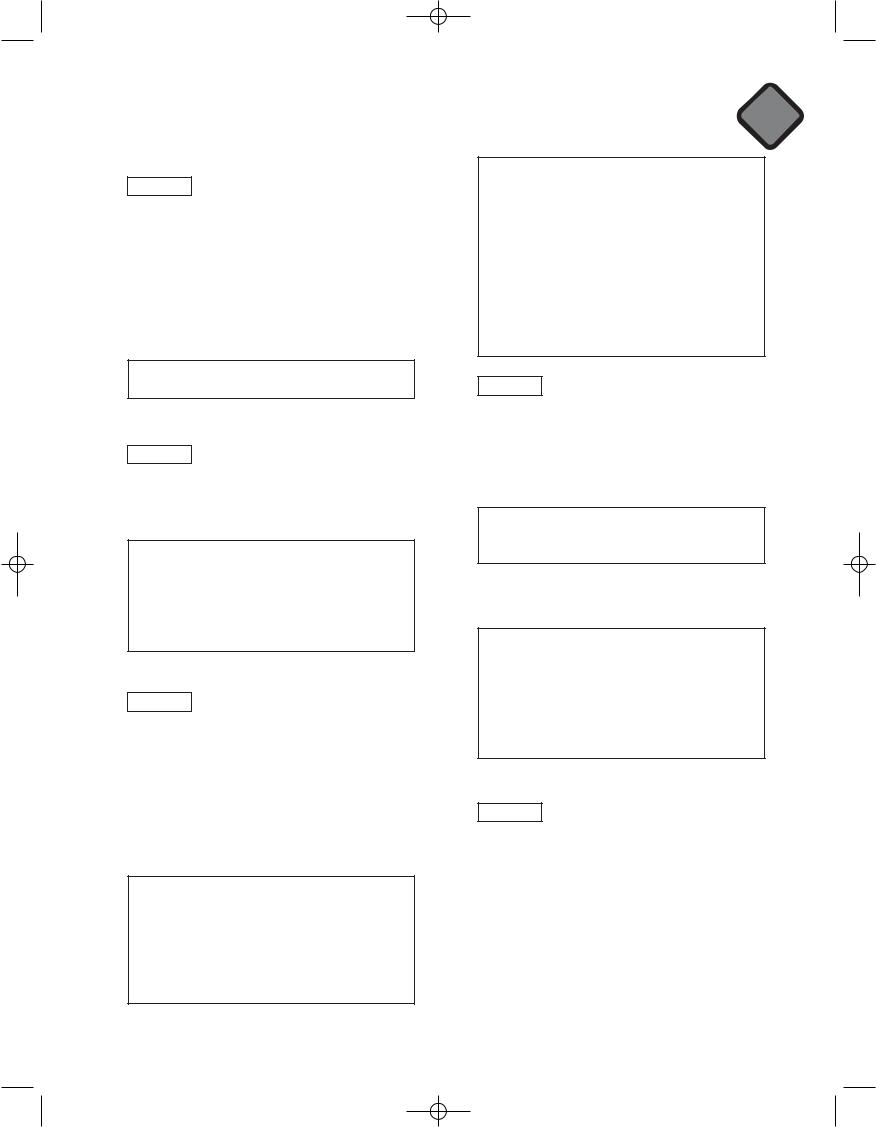
Spotlight 7 ts Mod 08 12-09-08 15:02 Page 117
Reading & Listening
1Focus Practising pronunciation and
intonation
ñAsk a S to read out the rubric. Explain the task and any new vocabulary. Ask individual Ss to read out the sentences. Check pronunciation and intonation. Play the recording, pausing after each sentence, as Ss repeat. Allow Ss time to say who says each sentence. Play the recording again as Ss check their answers.
Answer Key
R―C―C―R―C―C―R
ñ Elicit the meaning of any new vocabulary.
2Focus Reading for specific information
Ss read through the form. Elicit/Explain any new vocabulary. Ss read carefully and fill out the donation form. Check Ss’ answers.
Answer Key
1 |
25 |
|
2 |
month |
|
3 |
Matt Russell |
|
4 |
34 Scarsdale Road, Bromley, Kent |
|
5 |
Direct Debit (Bank Account) |
|
Speaking
3Focus Role-playing a dialogue
Have a S read out the rubric and help him/her explain the task. Elicit what the ad is about and the reason for the difference in price. Instruct Ss to work in pairs and use language from Ex 1 to make up dialogues. Walk around, monitoring the task and helping Ss where necessary. Ask pairs of Ss to act out their dialogues for the whole class. Elicit feedback. Ss edit their work. Record Ss’ role-play.
Suggested Answer Key
A:Hello, Save the Whales. How can I help you?
B:Hi. I’m interested in making a donation.
A:That’s great. Do you want to make a oneoff donation or a regular monthly one?
B:A one-off, please.
A: OK. That will be £50 to adopt a whale.
English in Use 8
B: How do I pay?
B:Direct Debit. Let me give you our account details. It’s Savings Bank, Account No. 56289012634. Could I take your name and address, please?
A:Of course. My name’s Margaret Owen and I live at 4 Laurel Hill, Great Dunmow, Essex.
B:Thank you very much, Ms Owen. You will receive your receipt soon.
A:Thank you. Good bye.
B:Good bye.
4Focus Practising word formation
ñFocus Ss’ attention on the tip and check understanding. Ask several Ss around the class to form verbs from the adjectives given. Write answers on the board. Elicit feedback, and check answers.
Answer Key |
|
|
|
1 |
blacken |
3 |
widen |
2 |
redden |
4 |
shorten |
ñElicit sentences containing the verbs, and check answers.
Suggested Answer Key
1The sky blackened as the dark clouds blocked out the sun.
2 His face reddened in anger.
3This road is too narrow. It needs to be widened.
4 Can you shorten my dress, please?
Pronunciation
5Focus Pronouncing /¡/, /¡º/
Draw Ss’ attention to the phonemes chart in the appendix. Ask them to find the two symbols. Pronounce the sounds slowly and clearly. Demonstrate where your tongue, teeth and jaw are positioned for the sound. Ss listen and repeat. Drill sounds with the class. Read the rubric and explain the task. Play the recording. Ss listen and tick the correct boxes. Ss compare answers. Allow Ss time to find more words. Check Ss’ answers and correct any mistakes.
117
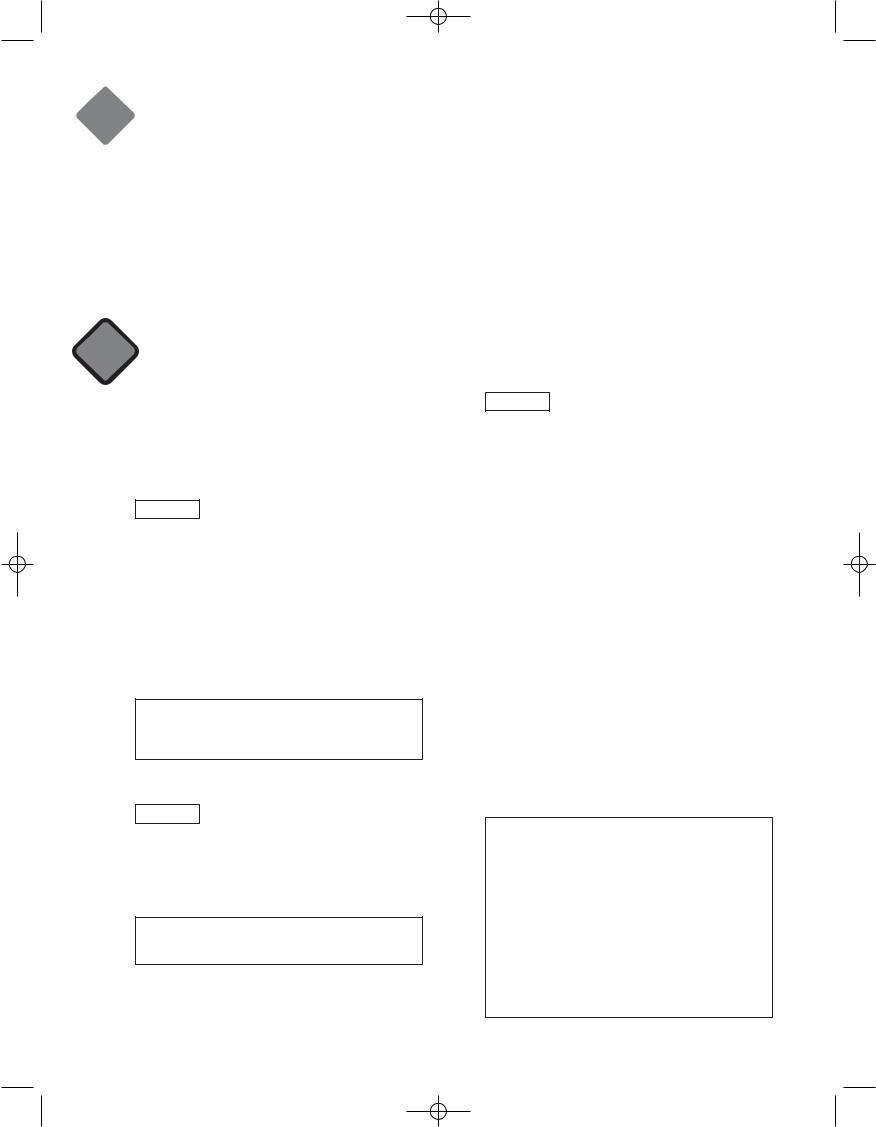
Spotlight 7 ts Mod 08 12-09-08 15:02 Page 118
8 |
|
English in Use |
|
|
|
|
|
|
|||
|
|
|
|
|
|
|
|
|
|
|
|
|
|
|
|
|
|
|
|
|
|
|
|
|
Answer Key |
|
|
|
|
|
Suggested Answer Key |
||||
|
|
|
|
|
|
|
|
|
|
||
|
|
|
/¡/ |
/¡º/ |
|
/¡/ |
/¡º/ |
|
|
/¡/ cry, try |
/¡º/ liar, buyer |
|
|
|
|
|
|
|
|
|
|
||
|
|
my |
|
|
pie |
|
|
|
|
|
|
|
|
|
|
|
|
|
|
|
|
|
|
|
|
mine |
|
|
fire |
|
|
|
|
|
|
|
|
|
|
|
|
|
|
|
|
|
|
|
|
tied |
|
|
why |
|
|
|
|
|
|
|
|
|
|
|
|
|
|
|
|
|
|
|
|
tired |
|
|
hire |
|
|
|
|
|
|
|
|
|
|
|
|
|
|
|
|
|
|
|
|
|
|
|
|
|
|
|
|
|
|
8 |
Extensive Reading |
to the section title Science and elicit what topics in this category and recycle the ones seen so far. what they think the unit will be about. Encourage
what vocabulary they will see in the unit.
Stimulating interest
Focus Ss’ attention on the section title pictures and ask them to identify what is in each. Ask the questions in the rubric to introduce the meaning of the words and the concept. Initiate a class discussion on the topic and brainstorm for more types of herbivores, carnivores and omnivores. Check pronunciation of the words and elicit the equivalents in L1, hinting that they might be true friends. Check Ss’ answers.
Answer Key herbivore: grasshopper
carnivore: hawk, snake, lion
Reading & Listening
2Focus Understanding dictionary entries
Instruct Ss to read the dictionary entry. Ask the question and check answers. Ask questions to elicit the part of speech, pronunciation, form and meaning of the compound noun.
Answer Key
The pictures and the entry are about a food chain.
3Focus Reading for detailed understanding
ñExplain task. Check Ss’ understanding. Allow them time to read through the text and complete the task. Monitor the task, making a mental note of Ss’ answers. Do not intervene. However, remind Ss of the S-V-O structure in sentences; always try to determine the part of speech of the missing word; and finally to look for the meaning. Play the recording. Ask for Ss’ answers. Elicit justifications.
Answer Key |
|
|
|
1 |
the |
5 |
These |
2 |
are |
6 |
them |
3 |
as |
7 |
there |
4 |
they |
8 |
a (the) |
|
|
|
|
ñAsk Ss to explain the meaning of the words in bold without the use of a dictionary, i.e. they can use synonyms, paraphrase etc. Elicit/ Explain the meanings and write them on the board. Ss should copy the words into the vocabulary section of their notebooks.
Answer Key
producers (n): sb or sth that makes sth herbivores (n): animals that eat plants only carnivores (n): animals that eat meat only omnivores (n): animals that eat both plants and animals
consumer (n): sb or sth that uses sth
fungi (n): plants that have no flowers, leaves or green colouring
bacteria (n): very small organisms break down (phr v): decompose
118
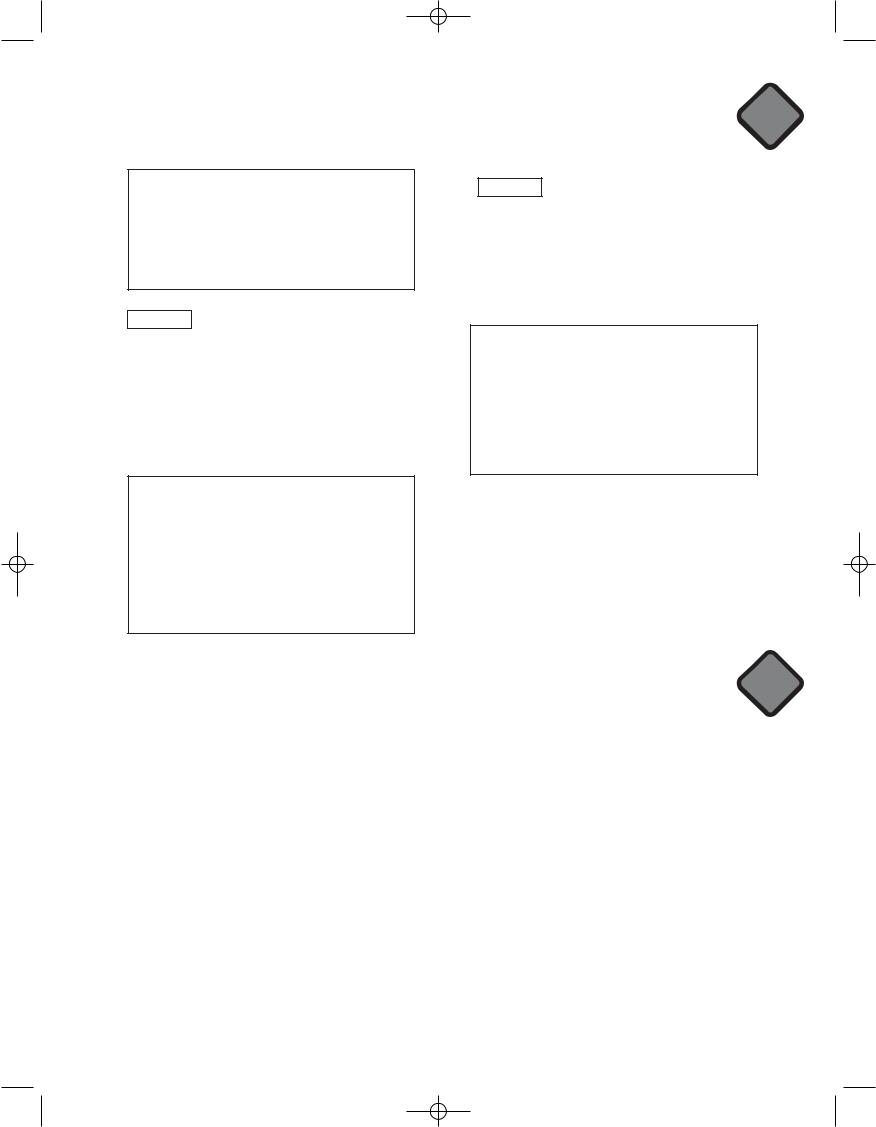
Spotlight 7 ts Mod 08 12-09-08 15:02 Page 119
compounds (n): substances
all over again (exp): from the beginning provides (v): gives
survive (v): to continue to exist even after being in a dangerous situation
extinction (n): the dying out of a species
4Focus Summarising the topic from a diagram
Allow Ss some time to read through the text again and relate it to the diagram. Allow them to make notes next to the pictures in the diagram or underline important words. Ss summarise the topic to their partners. Walk around the classroom monitoring Ss’ work and helping where necessary. Ask Ss to present their work to the class.
Suggested Answer Key
Plants get the energy they need from water and the sun. Certain animals, such as some insects, get their food from plants and other animals. Fungi and bacteria use the dead animals as food so nothing is wasted in nature. Everything is linked and a break in the chain would be a disaster.
Extensive Reading |
8 |
Project
5Focus Illustrating a food chain
Have a S read out the rubric and help explain the task. Allow Ss time to task. They can work with their partners. they have any difficulties and check their
several Ss to present their work. Pin the Ss’ work up on the walls of the classroom.
Suggested Answer Key
Plants and animals depend on each other. Microorganisms, insects, and fungi are decomposers. They provide chemicals for green plants. Plants are the food for plant eaters. The plant eaters are food for the meat eaters. These all provide waste materials for the decomposers.
Progress Check 8
Progress Check 8 and Look at Module 9 should be done in one lesson.
Answer Key |
|
|
|
|
|
|
|
|
|
|
|
||
1 |
1 |
power |
3 |
natural |
5 |
acid |
4 |
1 |
have to |
3 |
have to |
5 |
have to |
|
2 |
recycling |
4 |
endangered |
|
|
|
2 |
don’t have to |
4 |
doesn’t have to |
|
|
2 |
1 |
role |
3 |
habitat |
5 |
up |
5 |
1 |
don’t they |
3 |
aren’t they |
5 |
isn’t he |
|
2 |
burn |
4 |
poisons |
|
|
|
2 |
did he |
4 |
can she |
|
|
3 |
1 |
has been working |
|
|
|
6 |
1 |
I’m interested in making a donation |
|
|
|||
|
2 |
has been swimming |
|
|
|
|
2 |
A monthly donation, please |
|
|
|||
|
3 |
have you been taking care |
|
|
|
3 |
You’ll get our magazine every two months |
||||||
|
4 |
have been studying |
|
|
|
|
4 |
Could I take your name and address |
|
|
|||
|
5 |
have been donating |
|
|
|
|
5 |
How can I pay |
|
|
|
|
|
|
6 |
has/have been trying |
|
|
|
|
|
|
|
|
|
||
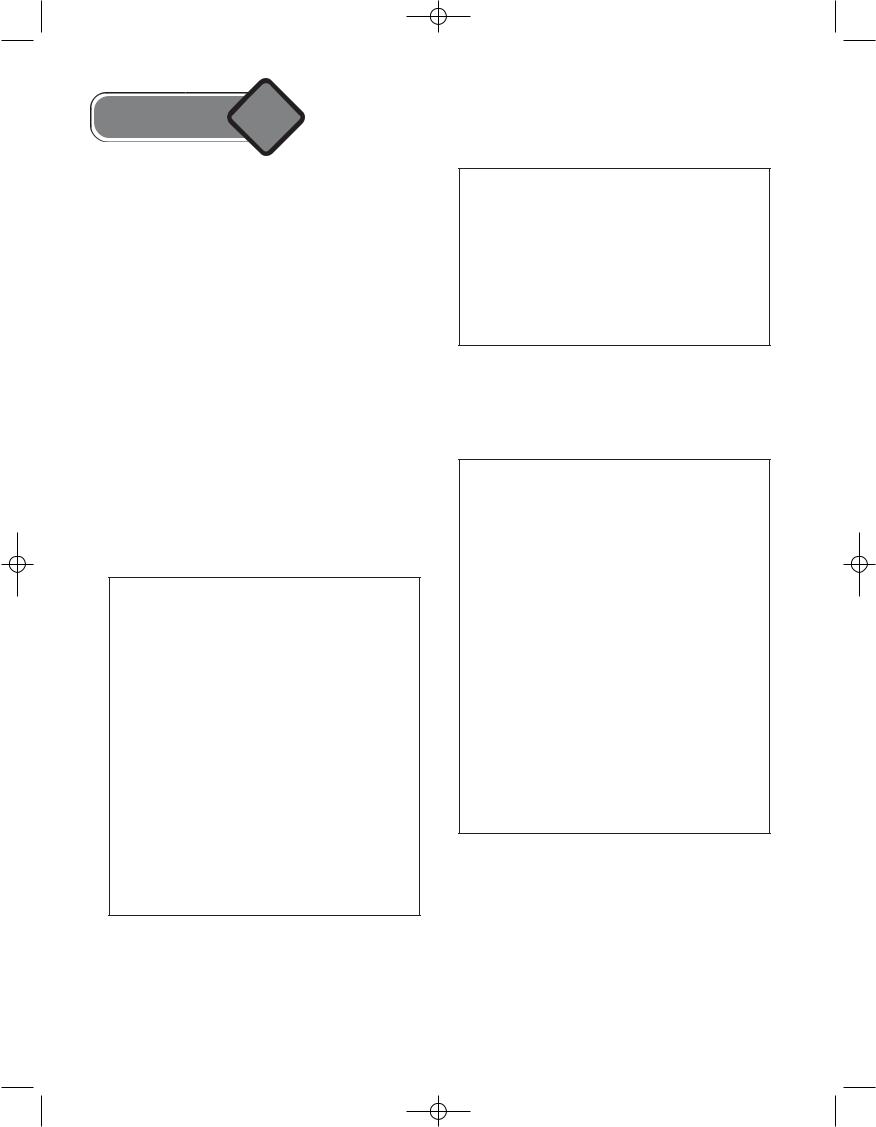
Spotlight 7 ts Mod 09 12-09-08 15:02 Page 120
Module 9
Before you start …
Ask Ss to take a quick look at Module 8. Ask Ss what they have done to help the environment recently. Ask Ss if they have ever planted trees or built nesting boxes. Ask questions and stimulate a short discussion on the topics. Adapt questions according to Ss’ answers.
Look at Module 9
ñAsk Ss to look at the title of the module, Shopping time, and elicit/explain the meaning (when people buy things). Refer Ss to the titles of the units on pp. 86-90 and ask them how they are related to the title of the module, Shopping time (p. 86 You are what you eat! ― the food people buy affects them, p. 88 Can I help you? ― buying things in shops. p. 90 Gifts for everyone! β buying presents for particular people).
ñUse pictures 1-3 to stimulate a discussion and to promote interest in the module as a warm-up activity. Ask questions to begin a discussion about topics that will be covered in the module, adjusting your questions according to Ss' responses.
Suggested Answer Key
Focus Ss’ attention on pic 1 (p. 91).
T: What page is picture 1 from? S1: It’s from page 91.
T: What can you see in picture 1?
S2: A cucumber lying on the beach, tanning and drinking a cocktail. It’s wearing flip flops. It’s very funny.
T:(Encourage Ss to look at the title of the section and article, as well as the sayings and idioms
accompanying the pictures.) What do you think this section is about?
S3: I think it is about food and food sayings. I think these pictures show food sayings.
T: What else can you see on page 91?
S4: A quiz about food and dictionary entries.
T:Do you have any food sayings in your language? Etc.
Pic 2 (p. 88)
What page is picture 2 from? What is it? What else can you see on p. 88? How do you think they are related to the title of the unit? What do you think the dialogue will be about?
Pic 3 (p. 86)
What page is picture 3 from? What can you see in the picture? How are the other pictures related? What do you think this section is about?
Find the page number(s) for
If necessary, elicit/explain each item. Allow Ss time to find the page numbers for each item and check Ss’ answers. As appropriate, elicit/explain each item.
Answer Key shopping lists (p. 86)
What is a shopping list? Who does the shopping in your family? Do they use a shopping list? Do you help with the shopping? What do you think this unit is about? What does the title mean? What is the text on p.87 about? What do you think the grammar point is here?
dictionary entries (p. 91)
What is a dictionary entry? What do you find out about a word? What entries are these?
an e-mail (p. 90)
Do you use e-mail? Who do you send e-mail to? What is this section about? What do you think the e-mail is about?
an article (p. 93)
What do you think this article is about? Where would you read this? How is it related to the section title Citizenship?
Listen, read and talk about …/Learn how to …/ Practise …/Write/Make
As described in the relevant section in Module 1.
120
